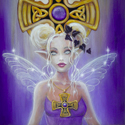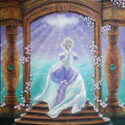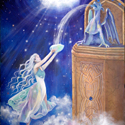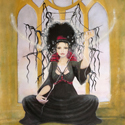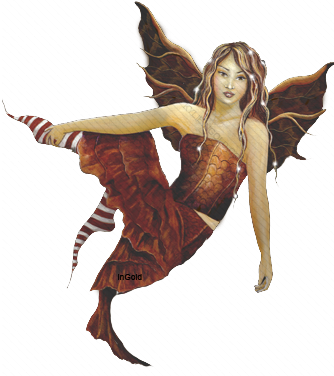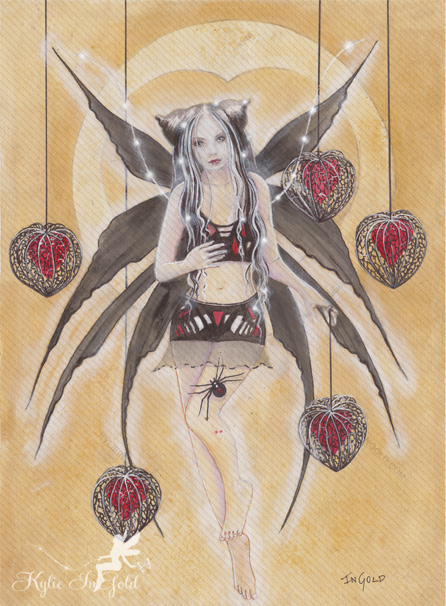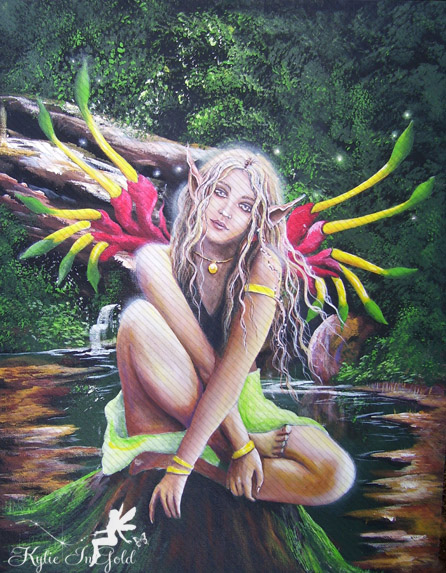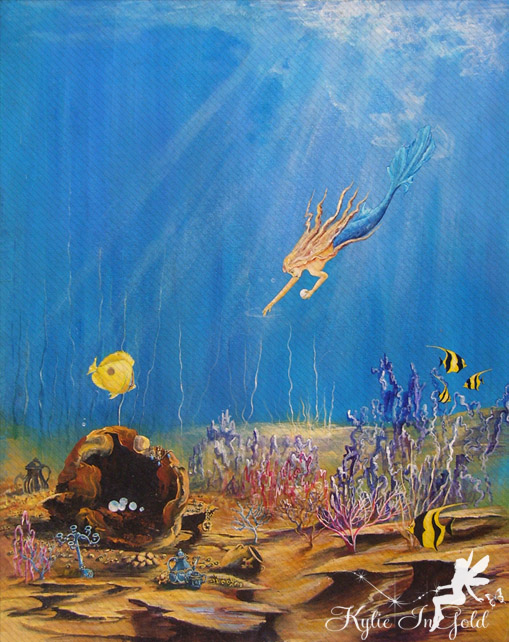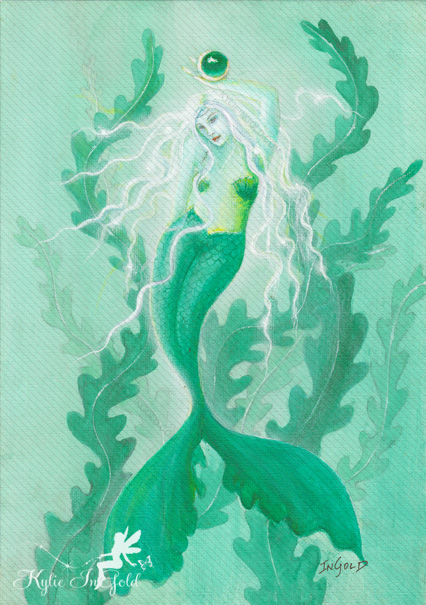Fairy Names
Aeval – A Faery Queen of southwestern Munster. In her district a debate was launched on whether the men were satisfying the woman’s sexual needs. In a midnight court, Aeval heard both sides and then decreed the men wrong and sentenced them to overcome their prudishness and accede to the woman’s needs. (Kisma)Asrai – are small and delicate female faeries who melt away into a pool of water when captured or exposed to sunlight.
Bean-Nighe – (ben-neeya)Similiar to that of the Banshee. The Washing women is the type of Banshee who haunts the lonely streams of Scotland and Ireland. Washing the blood-stained garments of those about to die. It is said that these spirits are the ghosts of women who died in childbirth and that they are fated to perform their task until the day when they would have normally died.
Bendith y Mamau (ben-dith uh momay) – Mother’s Blessing, which was the name of the fairies of the Carmarthenshire country in Wales; this saying became a prayer spoken to ward-off harm.
Black Annis – See Hags.
Bogles – Generally evil-natured Goblins although they are more disposed to do harm to liars and murderers.
Brown Man of the Muirs – Protector of wild beasts.
Brownie – His territory extends over the Lowlands of Scotland and up into the Highlands and Islands all over the north and east of England and into the Midlands. With a natural linguistic variation, he becomes the BWCA of Wales, the Highland Bodach and the Manx Fenodoree. In the West Country, Pixies or Pisgies occassionally perform the offices of a brownie and show some of the same characteristics, though they are essentially different. Border brownies are most characteristic. They are small men, about three feet in height, very raggedly dressed in brown clothes, with brown faces and shaggy heads, who come out at night to do the work that has been left undone by the servants. They make themselves responsible for the farm or house in which they live: reap, mow, her the sheep, prevent the hens from laying away, run errands, and give good counsel at need. A brownie can become personally attached to one member of the family.
Bwca – The Welsh name for the Brownie.
Cluricaun – After his day’s labors the Leprechaun enjoys a night’s revelry and then becomes known as the Cluricaun (kloor-a-kawn). He raids wine cellars and is known to take wild drunken rides through the moonlight on the backs of sheep or shepherds dogs.
Coblynau – Welsh Mine Goblin. Cousins to the Cornish Knockers. These creatures using mining tools, are seen working industriously at the seam faces. The knocking of their picks and hammers is lucky, a sign of heavy ore content.
Corrigan – Malignant nature spirits found in Brittany, often associated with phantoms of the dead.
Daoine Maithe – “The Good People”; Similar to the Gentry, they were said to be next to heaven at the Fall, but did not fall; Some think they are a people expecting salvation.
Dwarfs – Germany/Isle of Rugen/Swiss mountains. Short but powerfully built, they are generally bearded and aged in appearance, this is because they reach maturity when only three years old and are grey bearded by the age of seven. Their homes aree the mountains of Scandinavia and Germany where they mine for precious metals to work into arms and armour and other artifacts which are often endowed with magic. They cannot appear above ground tho one ray of sunlight and they will turn to stone. Other accounts say they spend daylight hours as toads.
Ellyllon – The name given to the Welsh elves. They are tiny, diaphanous fairies whose food is toadstools and fairy butter, a fungoid substance found in the roots of old trees and in limstone crevices. Their queen is Mab.
Elves – In Scandinavian mythology the fairy people were elves and were divided into two classes, the light elves and the dark elves, like the Seelie and Unseelie Court. In Scotland the fairy people of human size were often called elves and Faeryland was Elfame; in England it was the smaller Trooping Fay who were called elves, and the name was particularly applied to small fairy boys.
Fachan, The – From the West Highlands of Scotland.
Fays – The dialect name in Northumberland.
Fair Family or Fair Folk – The euphemistic name used by the Welsh for the fairies. (See Tylwyth Teg.)
Farisees, or Pharisees – The Suffolk name for fairies. The Suffolk children used to be confused between the farisees and the biblical mentions of the Pharises.
Fary – The dialect name in Northumberland.
Feeorin – A small fairy that is indicated as being, green-coated, generally red-capped, and with the usual fairy traits of love of dancing and music.
Fees – The fairiers of Upper Brittany.
Fenoderee – A type of Brownie from the Isle of Man. A willing worker of prodigious strength, the Fenoderee performs many labours for the farmers of Man. The Fenoderee was a member of the Ferrishyn – the faerie tribe of Man, until he made the mistake of absenting himself from their Autumn festival to court a mortal girl. His good looks were taken from him and he became the solitary, ugly creature he is now.
Feriers, or Ferishers – Another Suffolk name for the fairies.
Ferries – The usual name for the Shetland and Ocadian fairies.
Ferrishyn (Ferrishin) – A Manx name for the fairie tribe; the singular is “ferrish”. They are the Trooping Fairies of Man, though there does not seem to be any distinction between them and the Sleih Beggey. They are less aristocratic than the fairies of Ireland and Wales, and they have no named fairy king or queen. They were small, generally described as three feet in height, though sometimes as one foot. They could hear whatever was said out of doors. Every wind stirring carried the sound to their ears, and this made people very careful to speak of them favorably.
Fetes – The Fates of Upper Brittany.
Fir Darrig – (Fear dearg) delights in practiccal joking of a rather gruesome nature and therefore it is probably safer to humor him.
Foawr, (fooar) – Manx equivalent of Highland Fomorians/giants, stone-throwing.
Frairies – The Norfolk and Suffolk, local version of the word “fairy”.
Gentry, the – The most noble tribe of all the fairies in Ireland. A big race who came from the planets and usually appear in white. The Irish used to bless the Gentry for fear of harm otherwise.
Ghillie Dhu – A Scottish solitary faerie who inhabits certain birch hickets. His clothing is made of leaves and moss.
Glaistig, The – is a water faerie and is part seductive woman, part goat. The goat-like attributes she tries to hide under a long flowing green dress. The Glaistig lures men to dance with her before she feeds, vampire-like, on their blood. Her nature is typically faerie-perverse for she can also be benign and gently tend children or old people. She will also sometimes herd cattle for farmers.
Goblins – A breed of small, swarthy, malicious beings-although ‘goblin’ as a term is often used as a general name for thee uglier inhabitants of Faerie. They sometimes appear in the shape of animals which appropriately reflects their bestial nature. They are the thieves and villains of Faerie, companions to the Dead, especially on Halloween.
Good Neighbors – One of the most common Scottish and Irish names for the fairies.
Good People – The Irish often referred to their Sidhe in this manner. (See Daoine Maithe)
Green Children, The – The fairy are recorded in the medieval chronicles under such a name.
Green Lady of Caerphilly, The – Takes on the appearance of Ivy when she is not walking through the ruined castles she haunts.
Greencoaties – The name for the fairies that dwell in Lincolnshire Fen country.
Greenies – The euphemistic name used for the fairies in Lancashire, associated with the Jacobean Fairies.
Grey Neighbours, the – One of the euphemistic names for the fairies given by the Shetlanders to the Trows, the small gray-clad goblins whom the Shetlanders used to propitiate and fear, using against them many of the means used all over the islands as protection against fairies.
Guillyn Veggey – The Little Boys is a Manx term for the fairies who dwell on the Isle of Man.
Gwragedd Annwn, The – are Welsh water faeries, beautiful Lake Maidens who occassionally take mortals to be their husbands. One well-known legend tells of a young man who used to graze his cattle by a small lake near the Black Mountains. One day he saw a most enchanting creature rowing gently to and fro in a golden boat on the surface of the lake. He fell deeply in love with her and offered her some of the bread he had brought from home for his midday meal. She answered that the bread was too hard and disappeared into the depths. The young man’s mother gave him some unbaked dough to take with him the next day and he offered this to the faerie but she answered that it was too soft and again disappeared. On the third day he took some lightly baked bread, which passed. Three figures rose from the lake, and old man with a beautiful daughter on either side of him. The girls were identical and the father told the young farmer that he was willing to offer him the daughter with whom he was in love if he could point her out. The farmer would have given up in despair but one slightly moved her foot and he, recognizing her slipper, won her hand. The young farmer was warned that he would lose his wife if he ever should strike her three times causelessly. The Gwragedd Annwn had somme curious faerie ways; would weep at weddings and laugh at funerals, which led her husband to strike her, and she was forced to leave him. Though her sons she had left behind with all of their faery teachings they became great physicians.
Gwyllion (gwithleeon) – The evil mountain fairies of Wales. They are hideous female spirits who waylay and mislead travelers by night on the mountain roads. They were friends and patrons of the goats, and might indeed take goat form.
Hags – inhabiting the British Isles, who seem to personify winter, are probably survivals of the oldest goddesses. Some turn, like winter into Spring, from hideously ugly old wommen into beautiful young maidens, and others like Black Annis are cannibalistic.
Henkies – One of the names given to the Trows of Orkney and Shetland.
Hobgoblin – Used by the Puritans and in later times for wicked goblin spirits, but its more correct use is for the friendly spirits of the Brownie type. Hobgoblin was considered an ill omened word. “Hob” and “Lob” are words meaning the same kind of creature as the Hobgoblin. They are on the whole good-humored and ready to be helpful, but fond of practical joking.
Host, The – See Unseelie Court.
Hyster-sprites – Lincolnshire and East Anglian fairies/small and sandy-colored, with green eyes.
Jack-In-Irons – A Yorkshire giant who haunts lonely roads.
Jenny Greenteeth – Yorkshire River Hag who drowns children.
Jimmy Squarefoot – Frightening appearance but reletively harmless.
Kelpie, The – is a Scottish water faerie. Although sometimes appearing in the guise of a hairy man, this is more often seen in the form of a young horse. The Kelpie haunts rivers and streams and, after letting unsuspecting humans mount him, will dash into the water and give them a dunking. Each-Uisge (ech-ooshkya) or Aughisky (agh-iski) as he is known in Ireland, inhabits seas and lochs and is far more dangerous.
Killmoulis, The – particularly ugly Brownie who haunts mills. He is characterized by an enormous nose and no mouth. To eat he presumably stuffs the food up his nose. Although a Killmoulis works hard for the miller, he delights in practical jokes and can therefore be a hindrance rather than a help.
Klippe – The Forfarshire name for a fairy.
Leanan-Sidhe – (lan-awn-shee) On the Isle of Man she is a blood-sucking vampire and in Ireland the muse of poets. Those inspired by her live brilliant, tho short lives.Leprechaun – Generally described as a fairy shoemaker, this creature is a red-capped fellow whostays around pure springs and is known to haunt cellars. He spends his time drinking and smoking. One branch of the Leprechaun is known as the Fir Darrig, who is a practical joker; both are of the Solitary Fairies. Leprechauns have also been associated with the Earth-elemental Gnome, and when so done, is described as being a merry little fellow dressed all in green, instead of wearing a red cap, a leather apron, drab clothes and buckled shoes, and the boy, who has fairy blood in him, succeeds in winning a wealth of treasure from an underground cave, keeps his gain secret, and is the founder of a prosperous familiy.
Li’l Fellas, the – Another Manx euphemistic name for The Good Neightbours.
Little Folk – See Sleight Beggey.
Little People of the Passamaquoddy Indians, the – There are two kinds of Little People among the Passamaquoddy Indians, the Nagumwa-suck and Mekumwasuck. Both kinds are two and a half to three feet in height, and both are grotesquely ugly. The Passamaquoddy Indians, wholived close to the Canadian border, used to migrate to the ocean in the summer and move inland in the winter. When they moved, their fairies moved with them. The little People can only be seen by the Indians. They live in the woods and are fantastically and individually dressed. Their faces are covered with hair, which strikes an alien note to the Indians. Oral tradition has it that they were made of stone.
Lunantishess – The tribes that guard the blackthorn trees or sloes in Ireland; they let you cut no stick on the eleventh of November (the original November Day), or on the eleventh of May (the original May Day).
Mermaids – entice human lovers with their songs of enchantment. They cause ship-wrecking storms and are most frequently seen combing their long hair whilst admiring themselves in mirrors.
Merrows – The Irish Merpeople are called Merrows and they can be distinguished from other sea-dwelling faeries in that they wear red feather caps to propel themselves down to their homes in the depths. Should their caps be stolen, they can no longer return to their watery homes. The female Merrow are very beautiful and, like other mermaids, appear before storms as an omen, but they are gentle by nature and often fall in love with mortal fishermen. This can partly be explained by the extreme ugliness of the male Merrows. Despite their alaming aspect, the males too have their redeeming features as they are generally jovial in character.
Mooinjer Veggey (moo-in-jer vegar) – The Little People is a familiar Manxman term for the faeries who dwell on the Isle of Man; see Sleigh Beggey.
Muryans – Muryan is the Cornish word for ant. The Cornish belief about the fairies was that they were the souls of ancient heathen people, too good for Hell and too bad for Heaven, who had gradually declined from their natural size, and were dwindling down until they became the size of ants, after which they vanished from this state and no one knew what became of them.
Nuckelavee – is surely the most awful of the Scottish sea fairies. A monstrous horse with legs that are part flipper, a huge mouth and one fiery eye and, rising from its back joined to it at the waist, a hideous torso with arms that nearly reach the ground, topped by a massive head that rolls from side to side as though its neck was too weak to hold it upright. Worse than this tho is the horrible appearance of the creatures flesh, for it has no skin. Black blood coursing through yellow veins, white sinews and powerful red muscles are exposed. The Nuckelavee has an aversion to fresh running water and the pursued have only to cross it to escape.
Old People, the – Another Cornish name for the fairies.
Pechs, or Pehts – The Scottish Lowland names for fairies and are confused in tradition with the Picts, the mysterious people of Scotland who built the Pictish brughs and possibly also the round stone towers. The Pechs were considered tremendous castle builders and were credited with the construction of many of the ancient castles. They could not bear the light of day and so only worked at night, when they took refuge in their brughs or “sitheans” at sunrise. It seems likely that some historic memory of an aboriginal race contributed one strand to the twisted cord of fairy tradition.
Peg Powler – One of the many Green Hags with sharp teeth who drag their victims down to watery graves.
People of Peace – The Irish often refered to the Sidhe in this manner. The word sidhe means peace. See Daoine Sidhe in Faery Lineage.
People in the Hills, the – Fairies who live under the green mounds, or tumuli, all over England.
Phooka – an Irish Goblin with a variety of rough beast-like forms. He appears sometimes as a dog or a horse, or even a bull, but is generally jet-black with blazing eyes. As seemingly friendly, shaggy, sway-backed pony Phooka offers the unwary traveller a welcome lift; but once astride he is taken for a wild and terrifying gallop across the wettest and most thorny country, eventually to be dumped headlong into the mire or deposited in a ditch. The chuckle is that of the Phooka as he gallops away.
Picts – The original peoples who dwelled in the northeastern coast of Ireland. They were called the “Cruithne” and migrated down from Gaul or Galia (France). As the conquering waves of invaders arrived in Ireland, eventually the Picts retreated to the woods and lived in caves and underground forts. They were a small, dark people and became known as the classic Faery-people. See Pechs.
Pigsies – See Pixies.
Pixies, or Pigsies, or Piskies – These are the West Country fairies belonging to Somerset, Devon and Cornwall. There are varing traditions about the size, appearance and origin of the Pixies, but all accounts agree about their being dressed in green and about their habit of misleading travelers.
Plant Rhys Dwfen (plant hree thoovn) – The family name of a tribe of fairy people who inhabited a small land which was invisible because of certain herb that grew on it. They were handsome people, rather below the average in height, and it was their custom to attend the market in Cardigan and pay such high prices for the goods there that the ordinary buyer could not compete with them. They were honest and resolute in their dealings, and grateful to people who treated them kindly.
Portunes – Small agricultural fairies. It was their habit to labor on farms, and at night when the doors were shut they would blow up the fire, and, taking frogs from their bosoms, they would roast them on the coals and eat them. They were like very old men with wrinkled faces and wore patched coats.
Puck – Thanks to Shakespeare, the most famous of the mischievous shape-shifting hobgoblins. He is closely related to the Welsh Pwca and the Irish Phooka.
Redcap – is one of the most evil of the old Border Goblins. He lives in old ruined towers and castles, particularly those with a history of wickedness. He re-dyes his cap in human blood.
Seelie Court – Blessed Court; Name of the kindly fairy host, or benovolent Faery of the positive polarity, and is generally used to describe the Scottish fairies. The malignant fairies were sometimes called the Unseelie Court.
Selkies – The seas around Orkney and Shetland harbor the Selkies or Seal-Faeries (known as Roane in Ireland). A female Selkie is able to discard her seal-skin and come ashore as a beautiful maiden. If a human can capture this skin, the Selkie can be forced to become a fine, if wistful, wife. However, should she ever find her skin she immediately returns to the sea, leaving the husband to pine and die. The males raise storms and upturn boats to avenge the indiscriminate slaughter of seals.
Shellycoat – A Scottish bogie who haunts fresh water streams and is festooned with shells which clatter when he moves. He takes pleasure in tricking and bewildering travelers and leading them astray.
Sidhe, Sith, or Si (shee) – The Gaelic name for fairie, both in Ireland and the Highlands of Scotland. Very tall beings that seem to either shine or appear opalescent. The shining beings belong to the earthly realm; while the opalescent beings belong to the heavenly world. As with any shamanic practice there are three great worlds which we can see while we are still in the body: the heavenly, the earthly, and underworldly realms.
Silent Moving Folk – The Scottish fairies who live in green knolls and in the mountain fastnesses of the Highlands. See Still-folk.
Sleigh Beggey (sleigh beargar) – The Little Folk. A name given to fairies in the Manx tongue.
Sluagh (slooa) – Themost formidable of the Highland fairy people; The host of the Unforgiven Dead. By some scholars, they are regarded as the fallen angels, not the dead, but on the whole their accounts correspond closely to that given by Alexander Carmichael in ‘Carmina Gadelica’
Small People of Cornwall, the – Fairies were sometimes spoken of this way in Cornwall.
Solitary Fairies – The fairies who are chiefly malignant or ominous creatures, comprise this group, although there may be a few nature spirits or dwindled gods among them. An exception is the Brownie and its variants – though there are few family groups among the Brownies – some think that they were unacceptable in Faeryland because of their ragged, unkept appearance, and that they went off to the Seelie Court when they were properly dressed. However, this is only one school of thought on the subject. Other creatures, such as the Lepracaun, Pooka, and Bean Si, also comprise this group.
Spriggans – Grotesque and ugly in shape. Although quite small, they have the ability to inflate themselves into monstrous forms which has led humans to believe them to be the ghosts of old giants. Apart from their useful function as guardians of hill treasure, Spriggans are an infamous band of villains, skilled thieves, thoroughly destructive and often dangerous. They are capable of robbing human houses, kidnapping children (and leaving a repulsive baby Spriggan in exhange) causing whirlwinds to destroy fields of corn, blighting crops and all manner of other unpleasant mischief.
Sprites – A general name for fairies and other spirits such as Sylphs and nerieds.
Still-Folk – The Scottish name for the Highland fairies. See Silent Moving Folk.
Themselves, They, or Them that’s in it – The most common Manx names used in place of the word “fairy”, which was generally considered an unlucky word to use. It is sometimes said that “themselves” are the souls of those drowned in Noah’s flood.
Tiddy Ones, Tiddy Men, or Tiddy People – The Lincolnshire fenman’s nature spirits, which are also referred to as the Yarthkins or Strangers. Most of them were undifferentiated, a drifting mass of influenced and powers rather than individuals. The one among them personally known and almost beloved was the Tiddy Mun, who was invoked in times of flood to withdraw the waters.
Trooping Fay or Faery – The Faery have been divided into two main classes: trooping and Solitary. It is a distinction that hold good throughout the British Isles, and is indeed valid wherever fairy beliefs are held. The trooping fay can be large or small, friendly or sinister. They tend to wear green jackets, while the Solitary Faery wear red jackets. They can range from the Heroic Faery to the dangerrous and malevolent Sluagh, or tose Diminutive Fairies who include the tiny nature spirits that make the fairy rings with their dancing and speed the growth of flowers.
Trows – Live on the Shetland Islands, similiar to the Scandinavian Trolls and like them, have an aversion to daylight. They are frequently observed performing a curious lop-sided dance called ‘Henking’
Tylwyth Teg (terlooeth teig) – The Fair Family. The most unusual name for Welsh fairies, though they are sometimes called Bendith Y Mammau, in an attempt to avert their kidnapping activities by invoking a euphemistic name. They are fair-haired, and love golden hair. They dance and make fairy rings. They are like the Daoine Sidhe, and dwell underground or underwater. The fairy maidens are easily won as wives and will live with human husbands for a time. The danger of visiting them in their own country lies in the miraculous passage of time in Faeryland. They give riches totheir favourites, but these gifts vanish if they are spoken of.
Unseelie Court – Unblessed Court; They are never under any circumstances favorable to mankind. They comprise the Slaugh, or The Host, that is, the band of the unsanctified dead. The Unseelie Court are the malignant Faery of the negative polarity, made up of Solitary Faery.
Urisk – is a Scottish solitary faerie who haunts lonely pools. He will often seek out human company but his peculiar appearance terrifies those he approaches.
Verry Volk – The name of the fairies in Gower of Wales; little people dressed in scarlet and green.
Water Leaper – Preys on Welsh Fishermen.
Wee Folk – One of the Scottish and Irish names for the fairies.
White Ladies, the – The use of White Ladies for both ghosts and fairies is an indication of the close connection between fairies and the dead. The White Ladies were direct descendants of the Tuatha De Danann.
Wichtlein – from Southern Germany behave in much the same way as goblins. They announce the death of a miner by tapping three times. When a disaster is about to happen they are heard digging, pounding and imitating miners work.
